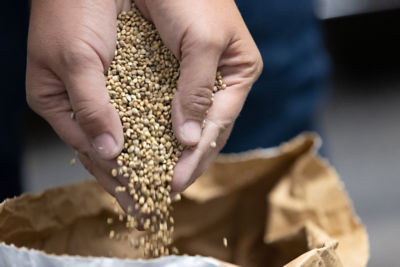Causal Agent
Moroccan watermelon mosaic virus (MWMV)
Papaya ringspot virus (PRSV; formerly Watermelon mosaic virus-1)
Watermelon mosaic virus (WMV; formerly Watermelon mosaic virus-2)
Zucchini yellow mosaic virus (ZYMV)
Vector
Aphis spp.
Distribution
PRSV, WMV, ZYMV – Worldwide
MWMV – Africa (Morocco, South Africa), France, Italy, Spain, and Portugal
Symptoms
All cucurbits are susceptible to potyviruses. Due to the similar nature of symptoms caused by the various potyviruses, it is recommended that samples be submitted to a diagnostic laboratory for proper identification. A characteristic symptom common to all curcubit polyviruses is a narrowing of tendril-like appearance of leaves, referred to as “shoe-string.”
PRSV: Symptoms can initially appear as vein-clearing of leaves. As symptoms progress, a light to dark green mosaic develops, followed by distortion and deep leaf serration. In cucumber, leaves tend to be distorted along the margins. In melon, severe infection can cause blistering of young leaves. In squash, severely affected leaves can assume a “shoe-string” appearance. In watermelon, the growing terminals tend to stand erect and new leaves are reduced in size. Early-season infection may lead to poor fruit set while late-season infection may result in deformed, blotchy fruit. Concentric ring-spot patterns may develop on the rind of watermelon fruit.
WMV/MWMV: Symptoms manifest as chlorosis of leaf veins. As the disease progresses. Leaves may develop a green mosaic and become deformed and blistered. In severe cases, leaf tissue surrounding the major veins develops a “shoestring” appearance. Early plant infection often leads to severely distorted, discolored fruit. When virus infection occurs after fruit set, generally fruit development is normal.
MWMV causes very severe mosaic and deformation of leaves and fruits in cucumber, squash and watermelon. In many melon cultivars, systemic infection manifests as necrotic leaf spots, which is often followed by complete plant collapse. MWMV is almost exclusively restricted to cucurbits, whereas WMV has the widest host range among the potyviruses.
ZYMV: Infected leaves are yellow with severe mosaic symptoms and also may exhibit blistering and “shoe-string.” Early-season infection can cause stunting of plants, uneven fruit color and fruit malformation.
 Papaya ringspot virus fruit infection.
Papaya ringspot virus fruit infection.
Conditions for Development
All potyviruses are vectored in a non-persistent manner by several species of aphid. These viruses can also be mechanically transmitted by workers and equipment to a lesser extent. The host range for some of these viruses includes legumes and weeds, however, infected weeds may remain asymptomatic.
Control
Grow resistant cultivars, control aphids and weeds and avoid planting near older cucurbit fields. Reflective mulches, equipment and worker sanitation, deep plowing of crop debris and destruction of cull piles may also help control these diseases.



